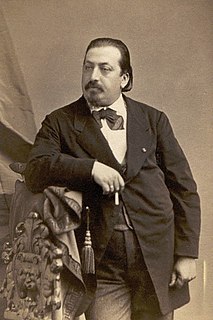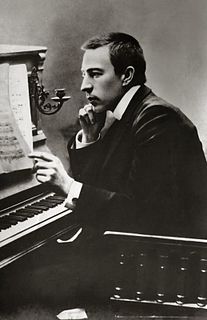Related Research Articles

Sonata, in music, literally means a piece played as opposed to a cantata, a piece sung. The term evolved through the history of music, designating a variety of forms until the Classical era, when it took on increasing importance. Sonata is a vague term, with varying meanings depending on the context and time period. By the early 19th century, it came to represent a principle of composing large-scale works. It was applied to most instrumental genres and regarded—alongside the fugue—as one of two fundamental methods of organizing, interpreting and analyzing concert music. Though the musical style of sonatas has changed since the Classical era, most 20th- and 21st-century sonatas still maintain the same structure.

The Rhapsody on a Theme of Paganini, Op. 43, is a concertante work written by Sergei Rachmaninoff for piano and orchestra, closely resembling a piano concerto, all in a single movement. Rachmaninoff wrote the work at his summer home, the Villa Senar in Switzerland, according to the score, from 3 July to 18 August 1934. Rachmaninoff himself, a noted performer of his own works, played the piano part at the piece's premiere on 7 November 1934, at the Lyric Opera House in Baltimore, Maryland, with the Philadelphia Orchestra conducted by Leopold Stokowski. Rachmaninoff, Stokowski, and the Philadelphia Orchestra made the first recording, on 24 December 1934, at RCA Victor's Trinity Church Studio in Camden, New Jersey. The English premiere on 7 March 1935 at Manchester Free Trade Hall also featured Rachmaninoff with The Hallé under Nikolai Malko.

Henryk Wieniawski was a Polish virtuoso violinist, composer and pedagogue who is regarded amongst the greatest violinists in history. His younger brother Józef Wieniawski and nephew Adam Tadeusz Wieniawski were also accomplished musicians, as was his daughter Régine, who became a naturalised British subject upon marrying into the peerage and wrote music under the name Poldowski.

Grigory Lipmanovich Sokolov is a Russian pianist. He is among the most esteemed of living pianists, his repertoire spanning composers from the Baroque period such as Bach, Couperin or Rameau up to Schoenberg and Arapov. He regularly tours Europe and resides in Italy.

Nikolai Karlovich Medtner was a Russian composer and virtuoso pianist. After a period of comparative obscurity in the 25 years immediately after his death, he is now becoming recognized as one of the most significant Russian composers for the piano.

The Piano Concerto No. 2 in C minor, Op. 18, is a concerto for piano and orchestra composed by Sergei Rachmaninoff between June 1900 and April 1901. From the summer to the autumn of 1900, he worked on the second and third movements of the concerto, with the first movement causing him difficulties. Both movements of the unfinished concerto were first performed with him as soloist and his cousin Alexander Siloti making his conducting debut on 15 December [O.S. 2 December] 1900. The first movement was finished in 1901 and the complete work had an astoundingly successful premiere on 9 November [O.S. 27 October] 1901, again with the composer as soloist and Siloti conducting. Gutheil published the work the same year. The piece established Rachmaninoff's fame as a concerto composer and is one of his most enduringly popular pieces.

Frédéric Chopin's Piano Sonata No. 2 in B-flat minor, Op. 35, is a piano sonata in four movements. Chopin completed the work while living in George Sand's manor in Nohant, some 250 km (160 mi) south of Paris, a year before it was published in 1840. The first of the composer's three mature sonatas, the work is considered to be one of the greatest piano sonatas of the literature.

The Symphony No. 2 in E minor, Op. 27 by Russian composer Sergei Rachmaninoff was written from October 1906 to April 1907. The premiere was performed at the Mariinsky Theatre in Saint Petersburg on 26 January 1908, with the composer conducting. Its duration is approximately 60 minutes when performed uncut; cut performances can be as short as 35 minutes. The score is dedicated to Sergei Taneyev, a Russian composer, teacher, theorist, author, and pupil of Pyotr Ilyich Tchaikovsky. The piece remains one of the composer's most popular and best known compositions.

Ruth Laredo was an American classical pianist.

Andrei Gavrilov is a Swiss pianist of Russian background.

Russian composer Sergei Rachmaninoff's Symphony No. 1 in D minor, his Op. 13, was composed between January and October 1895 at his Ivanovka estate near Tambov, Russia. Despite its poor initial reception, the symphony is now seen as a dynamic representation of the Russian symphonic tradition, with British composer Robert Simpson calling it "a powerful work in its own right, stemming from Borodin and Tchaikovsky, but convinced, individual, finely constructed, and achieving a genuinely tragic and heroic expression that stands far above the pathos of his later music."
The Piano Quartet in A minor, or more exactly the Quartet Movement for Piano, Violin, Viola and Cello in A Minor, by Gustav Mahler is the first movement to an abandoned piano quartet and the composer's sole surviving piece of instrumental chamber music.

Peter Roy Katin was a British classical pianist and teacher.

Piano Sonata No. 1 in D minor, Op. 28, is a piano sonata by Sergei Rachmaninoff, completed in 1908. It is the first of three "Dresden pieces", along with the Symphony No. 2 and part of an opera, which were composed in the quiet city of Dresden, Germany. It was originally inspired by Goethe's tragic play Faust; although Rachmaninoff abandoned the idea soon after beginning composition, traces of this influence can still be found. After numerous revisions and substantial cuts made at the advice of his colleagues, he completed it on April 11, 1908. Konstantin Igumnov gave the premiere in Moscow on October 17, 1908. It received a lukewarm response there, and remains one of the least performed of Rachmaninoff's works.
Alexander Borisovich Goldenweiser, was a Soviet and Russian pianist, teacher and composer.

Prince Rostislav is a symphonic poem by Sergei Rachmaninoff. It was composed when he was a student at the Moscow Conservatory, and is one of his earliest surviving compositions for orchestra. A typical performance of the work lasts from sixteen to twenty minutes.

The Valse-Scherzo in C major, Op. 34, TH 58, is a work for violin and orchestra by Pyotr Ilyich Tchaikovsky, written in 1877.

Andrey Rafailovich Kasparov is an Armenian-American pianist, composer, and professor, who holds both American and Russian citizenship.

The Symphony in D minor, WAB 100, was composed by Anton Bruckner in 1869 between Symphony No. 1 (1866) and Symphony No. 2 (1872). In 1895 Bruckner declared that this symphony "gilt nicht" and he did not assign a number to it. The work was published and premiered in 1924.
References
- ↑ "CD Baby". Archived from the original on 2012-10-04. Retrieved 2009-02-28.
- ↑ "bnet". Archived from the original on 2009-06-02. Retrieved 2009-02-28.
- ↑ Harrison, Max (2006). Rachmaninoff: Life, Works, Recordings. London: Continuum. p. 19. ISBN 978-0-8264-9312-5. Archived from the original on 2017-10-10. Retrieved 2016-11-10.
- ↑ "Talk Classical". Archived from the original on 2009-07-30. Retrieved 2009-02-28.
- ↑ "Chandos CD notes". Archived from the original on 2011-05-26. Retrieved 2009-02-28.